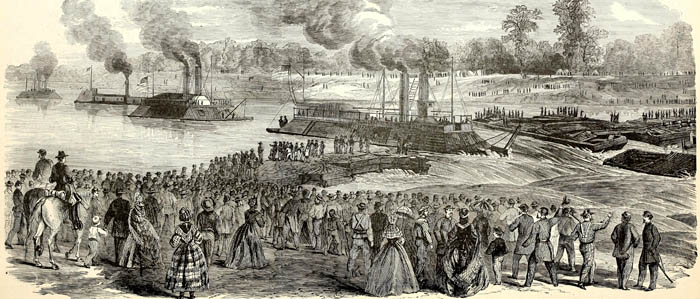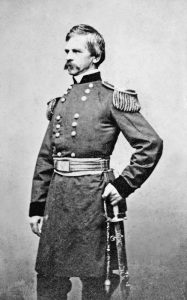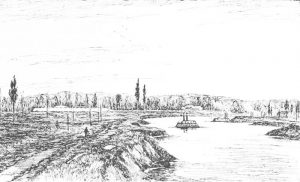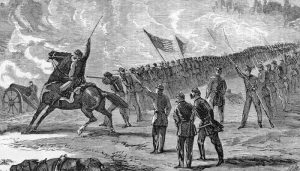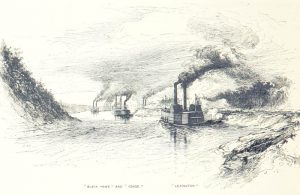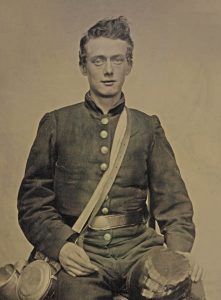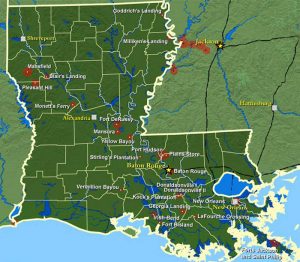The Red River Campaign of the Civil War, also called the Red River Expedition, was conducted from March 2 to May 20, 1864. Comprised of a series of battles fought along the Red River in Louisiana, it was one of the largest Army-Navy operations of the war. The Union initiative was fought between approximately 30,000 Union troops under the command of Major General Nathaniel P. Banks and Confederate troops under the command of General Richard Taylor, whose strength varied from 6,000 to 15,000.
The plan was to surround the main Confederate armies by using Banks’ Army of the Gulf to capture Shreveport, the capital of Confederate Louisiana, and the headquarters for the Army of the Trans-Mississippi. Shreveport was also the center of a small military-industrial complex that included armories, foundries, and a naval shipyard. As a gateway for a potential invasion of Texas, President Abraham Lincoln supported the plan.
The campaign was a Union failure, characterized by poor planning and mismanagement, and none of its objectives were fully accomplished. Alternative Confederate General Taylor successfully defended the Red River Valley with a smaller force. It was the last decisive Confederate victory of the war.
The campaign failure raised so many concerns in Washington that a congressional investigation was called, and Union General Nathaniel Banks was humiliated. He spent the remainder of the war in New Orleans or Washington testifying before Congress. Alternatively, Confederate General Richard Taylor was promoted lieutenant general and was given a command east of the Mississippi River.
Battles:
Fort DeRussy – March 14, 1864 – Part of the Red River Campaign, the Union launched a multi-purpose expedition into Rebel General E. Kirby Smith’s Trans-Mississippi Department, headquartered in Shreveport, Louisiana, in early 1864. Major General Nathaniel P. Banks and Rear Admiral David D. Porter jointly commanded the combined force. Porter’s fleet and Brigadier General A.J. Smith’s XVI and XVII Army Corps detachments of the Army of the Tennessee set out on March 12, 1864, up the Red River, the most direct route to Shreveport. Banks with the XIII and XIX Army Corps advanced by way of Berwick Bay and Bayou Teche. After removing various obstructions that the Rebels had placed in the river, the major impediment to the Union expedition was the formidable Fort DeRussy, an earthen fortification with a partly iron-plated battery designed to resist the fire of Union ironclads that might come upriver. Union Brigadier General A.J. Smith’s command had embarked on transports at Vicksburg and then disembarked at Simsport, on the 12th, about 30 miles from Fort DeRussy. Smith sent out some troops on the morning of the 13th to determine if any enemy was in their path. This force dispersed and chased an enemy brigade, after which Smith set his men in motion up the Fort DeRussy road. They did not proceed far before night. Early the next morning, the 14th, they continued the march, discovering that a Confederate division threatened their advance. Always mindful of this threat, Smith had to place part of his command in a position to intercept these Rebel forces if they attacked. Upon arriving at the fort, the enemy garrison of 350 men opened fire. Smith decided to use Mower’s division, XVI Army Corps, to take the fort and set about positioning it for the attack. Around 6:30 pm, Smith ordered a charge on the fort, and about 20 minutes later, Mower’s men scaled the parapet, causing the enemy to surrender. Fort DeRussy, which some had said was impregnable, had fallen, and the Red River to Alexandria was open.

Battle of Mansfield, Louisiana.
Mansfield – April 8, 1864 – Red River Campaign, also called the Battle of Sabine Crossroads, occurred in De Soto Parish, Louisiana. Major General Nathaniel P. Bank’s Red River Expedition had advanced about 150 miles up Red River by this time. Major General Richard Taylor, without any instructions from his commander, General E. Kirby Smith, decided that it was time to try and stem this Union drive. He established a defensive position just below Mansfield, near Sabine Cross-Roads, an important communications center. On April 8, Banks’ men approached, driving Confederate cavalry before them. For the rest of the morning, the Federals probed the Rebel lines. In the late afternoon, Taylor, though outnumbered, decided to attack. His men made a determined assault on both flanks, rolling up one and then another of Banks’ divisions. Finally, about three miles from the original contact, a third Union division met Taylor’s attack at 6:00 pm and halted it after more than an hour’s fighting. That night, Taylor unsuccessfully attempted to turn Banks’ right flank. Banks withdrew but met Taylor again on the 9th at Pleasant Hill. Mansfield was the decisive battle of the Red River Campaign, influencing Banks to retreat back toward Alexandria. The Confederate victory resulted in 694 Union casualties and 2,423 Confederate.
Pleasant Hill – April 9, 1864 – Part of the Red River campaign, Major General Nathaniel P. Banks’ Red River Expedition had advanced about 150 miles up Red River by April. Major General Richard Taylor, commander of the Confederate forces in the area, decided, without any instructions from his commander General E. Kirby Smith, that it was time to try and stem this Union drive. Taylor gained a victory at Mansfield on April 8. Banks withdrew from that battlefield to Pleasant Hill, but he knew that fighting would resume the next day. Early on the 9th, Taylor’s reinforced forces marched toward Pleasant Hill in the hopes of finishing the destruction of the Union force. Although outnumbered, Taylor felt that the Union army would be timid after Mansfield and that an audacious, well-coordinated attack would be successful. The Confederates closed up, rested for a few hours, and then attacked at 5:00 pm. Taylor planned to send a force to assail the Union front while he rolled up the left flank and moved his cavalry around the right flank to cut the escape route. The attack on the Union left flank, under the command of Brigadier General Thomas J. Churchill, succeeded in sending those enemy troops fleeing for safety. Churchill ordered his men ahead, intending to attack the Union center from the rear. Union troops, however, discerned the danger and hit Churchill’s right flank, forcing a retreat. In terms of the numbers of men involved, Pleasant Hill was the last major battle of the Louisiana phase of the Red River Campaign. Although Banks won this battle, he retreated, wishing to get his army out of west Louisiana before any greater calamity occurred. The battles of Mansfield and Pleasant Hill jointly influenced Banks to forget his objective of capturing Shreveport.
Blair’s Landing – April 12-13, 1864 – Part of the Red River campaign, Brigadier General Tom Green led his men to Pleasant Hill Landing on the Red River, where, at about 4:00 pm on April 12, they discovered grounded and damaged Union transports and gunboats of the army corps river transportation, and U.S. Navy gunboats, with supplies and armament aboard. Union Brigadier General Thomas Kilby Smith’s Provisional Division Corps, troops, and the Navy gunboats furnished protection for the army transports. Green and his men charged the boats. When Green attacked, Smith’s men used great ingenuity in defending the boats and dispersing the enemy. Hiding behind bales of cotton, sacks of oats, and other ersatz obstructions, the men on the vessels, along with the Navy gunboats, repelled the attack, killed Green, and savaged the Confederate ranks. The Confederates withdrew, and most of the Union transports continued downriver. On the 13th, at Campti, other boats ran aground and came under enemy fire from Brigadier General St. John R. Liddell’s Sub-District of North Louisiana troops, which harassed the convoy throughout the 12th and 13th. The convoy rendezvoused with Major General Nathaniel Banks’ army at Grand Ecore, providing the army with badly needed supplies.
Monett’s Ferry – April 23, 1864 – Near the end of the Red River Expedition, Major General Nathaniel P. Banks’ army evacuated Grand Ecore and retreated to Alexandria, pursued by Confederate forces. Banks’ advance party, commanded by Brigadier General William H. Emory, encountered Brigadier General Hamilton P. Bee’s cavalry division near Monett’s Ferry (Cane River Crossing) on the morning of April 23. Bee had been ordered to dispute Emory’s crossing, and he placed his men so that natural features covered both his flanks. Reluctant to assault the Rebels in their strong position, Emory demonstrated in front of the Confederate lines while two brigades searched for another crossing. One brigade found a ford, crossed, and attacked the Rebels in their flank. Bee had to retreat. Banks’ men laid pontoon bridges and, by the next day, had all crossed the river. The Confederates at Monett’s Ferry missed an opportunity to destroy or capture Banks’ army.
Mansura – May 16, 1864 – As Major General Nathaniel P. Banks’ Red River Expeditionary Force retreated down Red River, Confederate forces under Major General Richard Taylor attempted to slow the Union troops’ movements and, if possible, deplete their numbers or, better yet, destroy them. The Union forces passed Fort DeRussy, reached Marksville, and then continued east. At Mansura, Taylor massed his forces in an open prairie that controlled access to the three roads traversing the area, where he hoped his artillery could cause many casualties. Early on the morning of May 16, the Union forces approached, and skirmishing quickly ensued. After a four-hour fight (principally an artillery duel), a large Union force massed for a flank attack, inducing the Rebels to fall back. The Union troops marched to Simmsport. Taylor’s force could harass the enemy’s retrograde but was unable to halt it.
Yellow Bayou – May 18, 1864 – Major General Nathaniel P. Banks, during his retreat in the Red River Campaign, following the battles of Mansfield and Pleasant Hill, reached the Atchafalaya River on May 17. Once on the other side of the river, he would be shielded from the continuous Confederate harassment. But, he had to wait to cross the river until the army engineers constructed a bridge. On the 18th, Banks learned that Major General Richard Taylor’s force was near Yellow Bayou, so he ordered Brigadier General A.J. Smith to stop them. Since Smith could not comply himself, he ordered Brigadier General Joseph A. Mower to meet Taylor. The Yankees attacked and drove the Rebels to their main line. The Confederates counterattacked, forcing the Federals to give ground. The Union force finally repulsed the Confederates. This see-saw action continued for several hours until the ground cover caught fire, forcing both sides to retire. Yellow Bayou was the last battle of Banks’ ill-fated Red River Expedition, and it ensured that the Federals would escape as an army to fight again.
“The bullets flew like hailstones… The cries of the wounded was dreadful to hear. Their cry was water water but they could not be helped as they were between the two lines.”
— Union Corporal Abial Edwards
©Kathy Weiser-Alexander/Legends of America, May 2021.
Also See:
Civil War Timeline & Leading Events
Sources:
Battlefields.org
National Park Service Battle Descriptions (no longer available online)
National Park Service Civil War
U.S. Army Heritage and Education Center
Wikipedia

